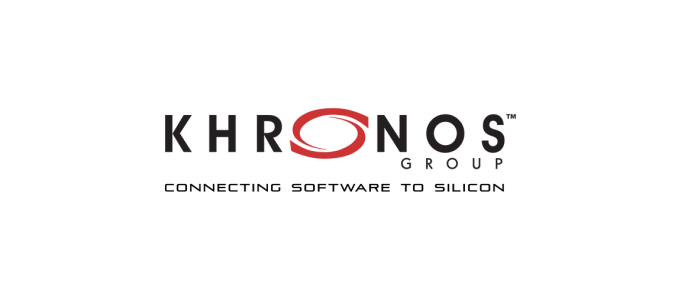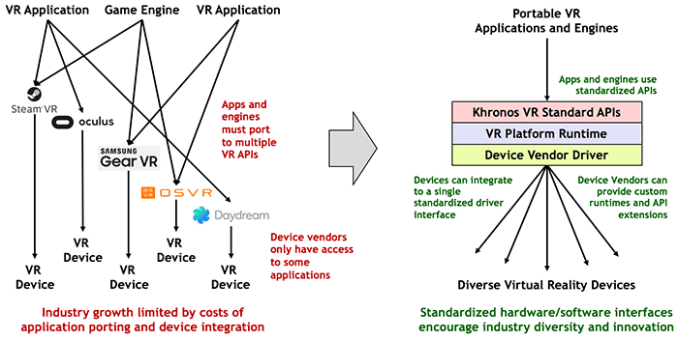The Khronos Group Announces New Standards Collaboration for VR Integration
by Dr. Ian Cutress on December 7, 2016 12:01 PM EST
It’s no secret that at this early point in the lifecycle of VR that there are many different platforms, solutions and paths to choose from when it comes to content and standards for motion and control. Due to the range of APIs created for game engines and different VR solutions, such as Steam VR, Oculus, OSVR, Daydream etc., it can be difficult for developers to create one-application-fits-all software. As a result, their software typically ends up specializing for a particular VR solution over others. This can arguably limit industry growth at the expense of differentiation.
The goal of the new Khronos VR Standards initiative, announced this week, is to create a set of standard APIs that portable VR applications and engines can use to interface with different hardware and vendor device drivers. Much in the same way that Vulkan is designed to be a low-level graphics standard that can target any capable set of hardware and software, the end goal here is to have a sufficient number of companies and developers on board to create a singular API interface for all future VR development, making a single app compatible with any device and software stack that adheres to the new standard(s).
At this time, Khronos is only putting out the announcement that this new VR Standards Initiative is in the early stages and encouraging companies in the VR space to get on board. The usual suspects are publicly participating (Google, Oculus, Valve, Intel, AMD, ARM, NVIDIA, EPIC Games, Razer, Tobii), and we were told that a number of other companies are also involved but not publicly at this time (we questioned Khronos about Microsoft, and Chinese participants as well).
Khronos confirmed that this is still early days for the initiative, at the point where the scope of the specification is still being determined. As a result, aside from headset tracking, controllers and other devices in a VR runtime, the scope could go beyond simple VR implementations and move to delocalized streaming and virtualized environments, depending on the participants in the Initiative. We were told that typical Khronos cycles for this sort of thing are 18-24 months before a ratified standard is in place.
From Khronos’ press release:
“Khronos has been on the forefront of advanced graphics and system APIs for over 15 years, and in keeping with that tradition and obligation to the industry at large has embarked on a new, vitally needed set of APIs and standards for the emerging VR market. We applaud the industry-leading companies that are coming together as Khronos members for this endeavor, and expect the whole industry will share our sentiment,” said Jon Peddie, President of JPR.
Any company interested in participating should get in contact with Khronos. There have been some initial presentations at SIGGRAPH Asia this week.
Source: Khronos












13 Comments
View All Comments
edzieba - Wednesday, December 7, 2016 - link
We can hope this does not fall to the curse of early standardisation (like VRML). Also interesting that HTC are absent even though Valve are involved.T1beriu - Thursday, December 8, 2016 - link
HTC built what VALVE designed.BrokenCrayons - Wednesday, December 7, 2016 - link
The VR industry badly needs standardization if it expects to prosper. Right now, besides the obvious cost barriers, the technological problems that prevent it from working with iGPUs, and the nausea issue, the fact that one company's gear works with a certain program and not with another harkens back to bad old days of 3Dfx Glide versus early DirectX versus whatever random thing PowerVR was doing. Consolidation of the graphics industry has really help with that problem since there are now only two GPU manufacturers making hardware for one dominant standard. Look at how much its done to help promote hardware progress and low prices...oh wait...nevermind.MajGenRelativity - Wednesday, December 7, 2016 - link
I doubt VR will work with integrated GPUs for quite some time. iGPUs don't have anywhere near the graphical horsepower required. There would have to be an increase in 1) iGPU processing power 2) iGPU VRAM bandwidth 3) Algorithmic tricks to reduce the necessary pixel rendering for VR.fanofanand - Wednesday, December 7, 2016 - link
HBM2 would solve your second issue.MajGenRelativity - Wednesday, December 7, 2016 - link
HBM2 or HMC or even eDRAM, any of the above would solve it. If only Intel gave a damn about integrated graphics and eDRAM for anything other than mobile. Maybe AMD can pull something off with Zen to shake up the industry.BrokenCrayons - Thursday, December 8, 2016 - link
Yes, you're correct that current generation iGPUs are insufficient to drive VR hardware, but a lot of that problem is rooted in high screen resolutions which might optionally be lowered in the inevitable race to the bottom that VR gear will see in the future if it becomes mainstream while at the same time, iGPU technology slowly improves.I'm not a fan of VR technologies as I've had my fill with prior attempts to field headgear by other companies prior to Oculus opening the door to a new generation of equipment. However, in the present day, with the vast majority of computers sold being non-upgradeable laptops and a smaller number of business-class and low-end consumer desktops, there's a very comparatively small number of computers capable of driving VR hardware and an even smaller subset of those computers' owners who are actually interested in making a purchase at the current price. Until the future equivelant of an mid- to low-cost laptop can drive VR, there simply won't be broad enough appeal to support the number of competing companies that are trying to turn a profit selling their hardware. That's a huge hurdle that standardization can somewhat mitigate by at least improving compatibility and increasing the incentives of software developers to support encased, head mounted dual screen setups that we're currently seeing marketed as virtual reality equipment.
fanofanand - Wednesday, December 7, 2016 - link
Sony had better get with the picture quickly. They have a solid lead right now with PS VR (If for no other reason than cost, and that PS4s are ubiquitous) but they will be rendered obsolete if a unified API is created and Sony isn't in on that action.T1beriu - Thursday, December 8, 2016 - link
Consoles don't need to join standards. Consoles set standards.close - Friday, December 9, 2016 - link
For consoles you mean... Their very core was changed in order to follow standards imposed by the PC industry: x86 CPU, relatively standard GPU (although in a custom implementation), standard PC architecture, standard connectivity, even the OS is moving towards the PC. And what's not borrowed from the PC ecosystems is borrowed from the mobile one (like the concept of a store).I can think of very few things that consoles imposed on the rest of the world. Except a sense of entitlement and superiority to some people. But PCs have also done this to the same kind of people for decades.